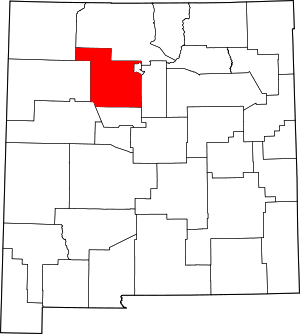Cochiti, New Mexico
Cochiti (/ˈkoʊtʃəti/; Eastern Keresan: Kotyit [kʰocʰi̥tʰ] - "Forgotten", Navajo: Tǫ́ʼgaaʼ) is a census-designated place (CDP) in Sandoval County, New Mexico, United States. A historic pueblo of the Cochiti people, it is part of the Albuquerque Metropolitan Statistical Area. The population was 528 at the 2010 census. Located 22 miles (35 km) southwest of Santa Fe, the community is listed as a historic district on the National Register of Historic Places.[2]
Cochiti, New Mexico | |
|---|---|
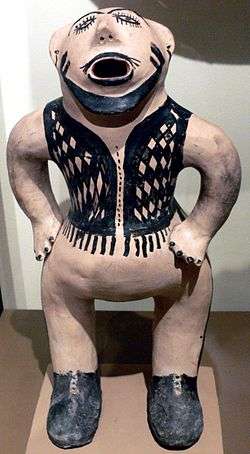 Cochiti Pueblo clay figure (mono), circa 1883 | |
 Flag | |
 Location of Coochi | |
| Country | United States |
| State | New Mexico |
| County | Sandoval |
| Area | |
| • Total | 1.2 sq mi (3.1 km2) |
| • Land | 1.2 sq mi (3.1 km2) |
| • Water | 0.0 sq mi (0.0 km2) |
| Elevation | 5,276 ft (1,608 m) |
| Population (2010) | |
| • Total | 528 |
| • Density | 440/sq mi (170/km2) |
| Time zone | UTC-7 (Mountain (MST)) |
| • Summer (DST) | UTC-6 (MDT) |
| Area code(s) | 505 |
| FIPS code | 35-16560 |
| GNIS feature ID | 1867383 |
| Website | http://www.pueblodecochiti.org/ |
Cochiti Pueblo | |
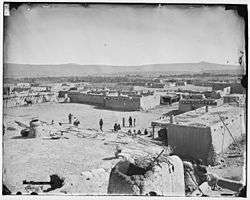 Cochiti Pueblo between c. 1871-c. 1907 | |
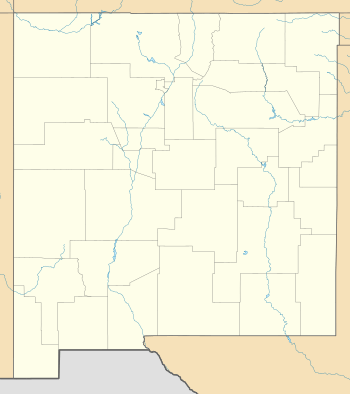  | |
| Nearest city | Cochiti, New Mexico |
| Coordinates | 35°36′32″N 106°20′41″W[1] |
| Area | 61 acres (25 ha) |
| Built | 1250 |
| Architect | Fr. Juan de Rozas |
| Architectural style | Pueblo |
| NRHP reference No. | 74001205[2] |
| NMSRCP No. | 234 |
| Significant dates | |
| Added to NRHP | November 20, 1974 |
| Designated NMSRCP | February 1, 1972 |
Geography
According to the United States Census Bureau, the CDP has a total area of 1.2 square miles (3.1 km2), all of it land.
Demographics
At the 2010 census,[3] there were 528 people, 157 households and 127 families residing in the CDP. The population density was 440 per square mile (169.9/km²). There were 178 housing units at an average density of 149.9 per square mile (59.1/km²). The racial makeup of the CDP was 95.1% Native American, 1.5% White, 1.3% from other races, and 2.1% from two or more races. Hispanic or Latino of any race were 6.6% of the population.
There were 157 households of which 28% had children under the age of 18 living with them, 40.8% were married couples living together, 29.3% had a female householder with no husband present, and 19.1% were non-families. 18.5% of all households were made up of individuals and 9.0% had someone living alone who was 65 years of age or older. The average household size was 3.36 and the average family size was 3.76.
31.8% of the population were under the age of 19, 6.4% from 20 to 24, 23.8% from 25 to 44, 20.6% from 45 to 64, and 17.4% who were 65 years of age or older. The median age was 34.5 years.
In the 2000 census, the median household income was $31,875 and the median family income was $37,500. Males had a median income of $19,231 compared with $21,641 for females. The per capita income for the CDP was $9,153. About 21.4% of families and 20.9% of the population were below the poverty line, including 21.3% of those under age 18 and 11.8% of those age 65 or over.
Cochiti pueblo and Cochiti people
The Cochiti pueblo people are a federally recognized tribe of Native Americans. According to the Keres Online Dictionary the Keresan-name for the People of Cochiti Pueblo is Kʾúutìimʾé ("People from the Mountains, i.e. Cochiti people").[4]
The Cochiti speak Keres, an eastern Keresan language, which is a language isolate.[5] In the early 21st century, the Keres Children's Learning Center, an independent Keres immersion school, was founded to aid with preservation of their language and culture. It has added grades since its founding.[6]
The pueblo administers 53,779 acres (217.64 km2) of reservation land and possesses concurrent jurisdiction over the Kasha-Katuwe Tent Rocks National Monument.[5]
The pueblo celebrates the annual feast day for its patron saint, San Buenaventura, on July 14.
History
The Cochiti people are thought to be descended from the Ancestral Puebloans (formally known as Anasazi).[7] The ancestors of the Cochiti people were divided in two groups, one was located in the pueblo of Katishtya (later called San Felipe pueblo) in the south and the other was located in Potrero Viejo, a mesa in northern central New Mexico.[5] Approximately 12 miles northwest of the present-day Cochiti Pueblo, a temporary pueblo known as Hanut Cochiti had been established.[5]
In 1598, Spanish conquistador, Juan de Oñate came to Cochiti Pueblo.[5] With the arrival of Oñate and the Spanish, the Cochiti people (and other tribes) were forcing to pay taxes in crops, cotton, and work.[7] The Spanish Catholic missionaries attacked their religion and renamed the Pueblos with Catholic saints’ names and began a program of church construction, such as San Buenaventura mission at Cochiti.[7] As time went on, the Spaniards routinely tortured Indians for practicing their traditional religion and they forced the Indians to labor and/or slavery.[7]
The Cochiti pueblo people took part in the Pueblo Revolt of 1680, an uprising of the Native Americans against the Spaniards.[5] When Spanish Governor Antonio de Otermin reconquered New Mexico, the tribe retreated with the Keresan tribes of San Felipe and Santo Domingo (now called Kewa) to the Potrero Viejo.[5] The Cochiti people remained at Potrero Viejo until 1693, when they were forced to flee Spanish Governor Don Diego de Vargas and his troops.[5]
Art
Potters of Cochiti and Kewa Pueblo (formerly Santo Domingo Pueblo) have made traditional pots for centuries, developing styles for different purposes and expressing deep beliefs in their designs. Since the early decades of the 20th century, these pots have been appreciated by a wider audience outside the pueblos. Continuing to use traditional techniques, in the late 20th and early 21st centuries, potters have also expanded their designs and repertoire in pottery, which has an international market.
Notable people from Cochiti Pueblo
- Helen Cordero, storyteller and pottery
- The Herrera-Ortiz family of Cochiti Pueblo is known for their traditional pottery, as well as other forms of art.
- Laurencita Herrera (1912–1984), storyteller pottery and vessels
- Virgil Ortiz (born 1969), potter and designer
- Inez Ortiz (1960–2008), traditional Cochiti potter
- Lisa Holt (born 1980), Cochiti potter with modern influence
- The Montoya-Peña family of both Cochiti Pueblo and San Ildefonso Pueblo, known for their painting
- Martina Vigil Montoya (1856–1916)
- Tonita Peña (1893–1949), painter
- Joe Herrera (1923–2001), painter
- Diego Romero (born 1964), pottery and printmaking
- Mateo Romero (born 1966), painter
In popular culture
In 1969, a documentary film about a Native American boy's life on a Cochiti pueblo was made for Sesame Street's second season (1970–1971), aired on December 9, 1970. Subjects it covered included a game of shinny, making tortillas, and making necklaces out of corn for summertime sale to tourists.[8]
Gallery
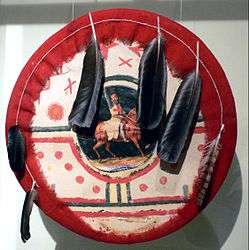 Cochiti Pueblo Ceremonial shield, made before 1883
Cochiti Pueblo Ceremonial shield, made before 1883
See also
References
- "US Gazetteer files: 2010, 2000, and 1990". United States Census Bureau. 2011-02-12. Retrieved 2011-04-23.
- "National Register Information System". National Register of Historic Places. National Park Service. July 9, 2010.
- "U.S. Census website". United States Census Bureau. Retrieved 2008-01-31.
- Keres Online Dictionary
- "Cochiti Tribe of New Mexico". Legends of America. Retrieved 2019-10-23.
- Lyla June Johnston, "The Preservation of Keres", Indian Country Today Network, Issue 41, 19 October 2016; accessed 20 October 2016
- "Cochiti Pueblo (Native Americans of the Southwest)". what-when-how.com. Retrieved 2019-10-23.
- Classic Sesame Street film - Native American Cochiti Pueblo, YouTube
Further reading
- Chapman, Kenneth Milton (1977). The Pottery of Santo Domingo Pueblo: A Detailed Study of Its Decoration. School of American Research, University of New Mexico Press, Albuquerque, New Mexico, ISBN 0-8263-0460-5; original published in 1936 as volume 1 of the Memoirs of the Laboratory of Anthropology OCLC 3377512
- Verzuh, Valerie K. (2008). A River Apart: The Pottery of Cochiti and Santo Domingo Pueblos. Museum of New Mexico Press, Santa Fe, New Mexico, ISBN 978-0-89013-522-8
